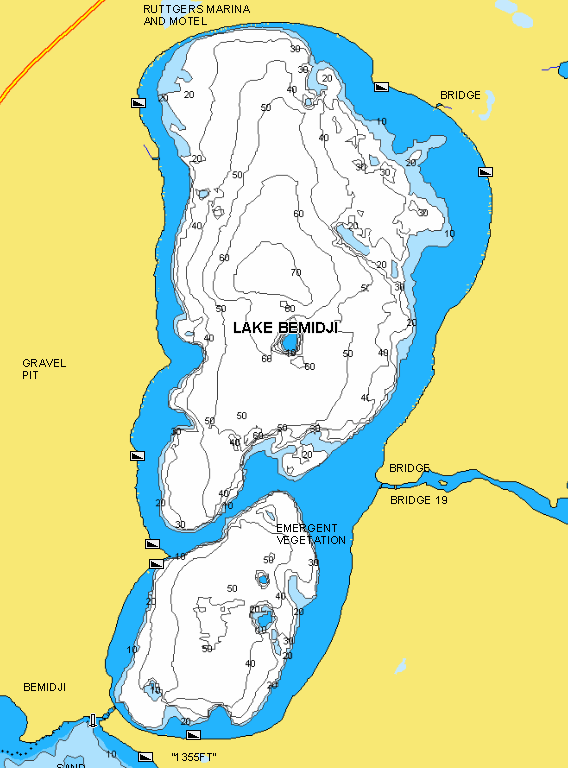
A jewel among a string of seven gems on the Mississippi River in Beltrami County, Lake Bemidji is filled with structure that holds fish year-round. Covering more than 6,000 acres, Bemidji is sandwiched between Lake Irving on the upstream side and Stump Lake, downstream along the river. The others in the chain include Plantagenet, Big and Little Marquette, and Carr lakes.
The lake features two main basins, divided by the prominent Diamond Point Bar which stretches shore-to-shore from southwest to northeast. The city of Bemidji, Bemidji State University, and Bemidji State Park take up much of the southern, western, and northern shorelines, which gives anglers looking for launch ramps and access points plenty of options.
Team Northland member Paul Nelson operates Bemidji Area Lakes Guide Service, (218) 759-2235, as well as writing a weekly outdoors column for the Bemidji Pioneer newspaper. He says the lake is a wonderful angling destination all year long, but it’s one of the best waters in the state for late-season action.
Lake Bemidji is filled with structure, and those spots called out by name in this report are but a taste of the many sweet spots that produce gamefish of all species. Nelson urges anglers to use the information provided here to search out and fish areas of the lake offering similar structures.
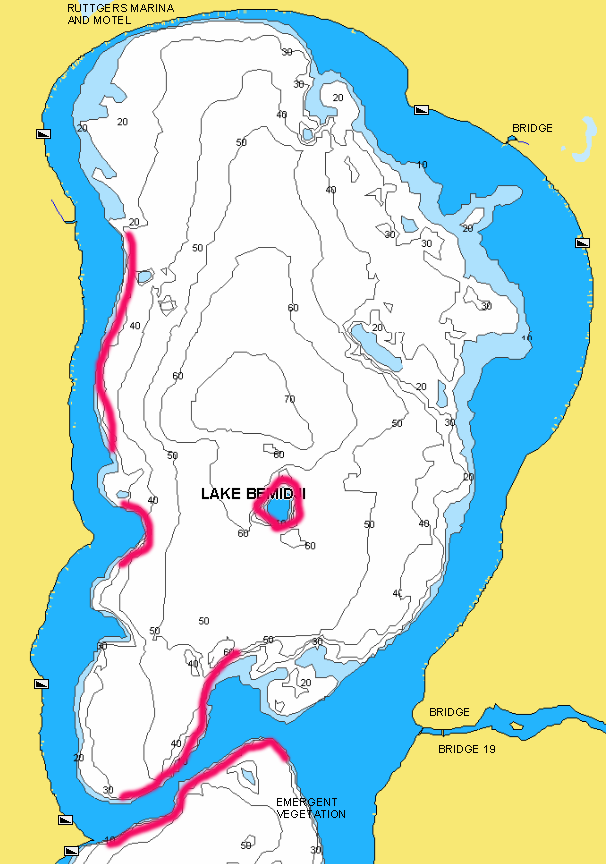
1. Lake Bemidji has a reputation as an outstanding destination for late-season anglers. As walleyes are bulking up on minnows and young-of-the-year perch for the coming winter, Nelson suggests vertical jigging steep and deep structures, especially along the edges of Diamond Point Bar, Cameron Point, Rockpile Bar, and the steep western shoreline north of Cameron Point. His preference is a ¼- to 3/8-ounce RZ Jig tipped with a shiner minnow. To keep the bait on the jig, run the hook point into the baitfish’s mouth and out one of the gills, then hook the shiner through the body from belly to dorsal. Also, try a Deep-Vee Jig rigged with a shiner or Impulse® Smelt Minnow or a shiner-tipped Fire-Ball® with a free-swinging Sting’r Hook.
For yellow perch, focus on the shallow or deep flats along the west and northeast shorelines. Shallow flats run from about the 5- to 12-foot depths. Deep flats start at the transition from a hard to soft bottom, and most fish usually hold closer to the transition than farther out. Search for fish with sonar equipment, but don’t be discouraged if you don’t spot them. They often root the bottom for insect larvae and may not appear on the screen. Drop a ¼- to 1/8-ounce Buck-Shot Rattle Spoon rigged with a tungsten Gill-Getter Jig tipped with an Impulse® Skeleton Minnow as a dropper below the spoon. The chances of catching a few bonus walleyes here are better than fair.
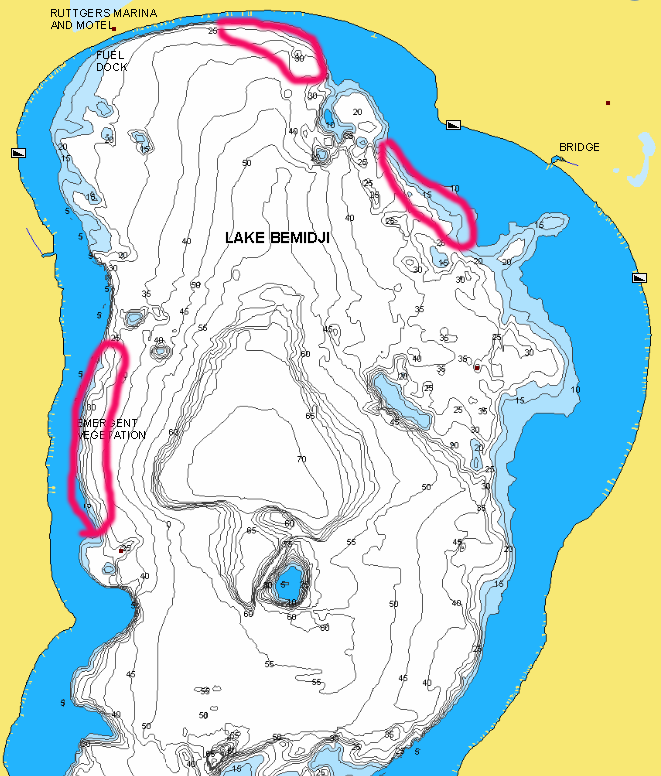
Target big northern pike in the fall with a ½-ounce Bionic Bucktail® Jig rigged with a live 4-inch sucker minnow by trolling the western shoreline areas, or anywhere you find cabbage weeds—at a fairly fast speed.
While the muskie population in Bemidji is fair, size is above average, which accounts for its popularity, especially during the fall and late fall when tullibees spawn. Try casting a Reed-Runner Magnum Spinnerbait to large structures such as Diamond Point Bar, Cameron Point, and Rockpile Bar. If you see other anglers hammering the popular spots, however, Nelson recommends searching for similar, but the smaller, structure—places that don’t get as much fishing pressure.
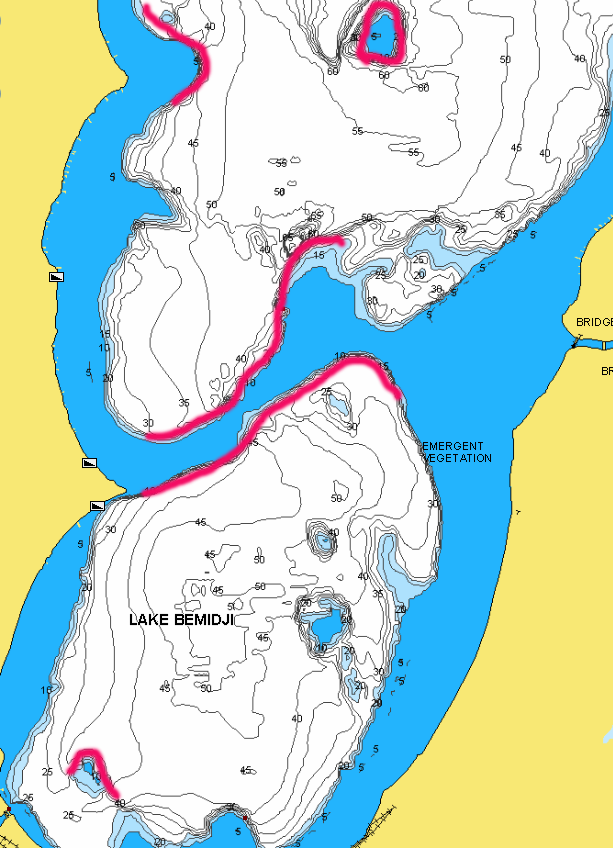
2. During the winter, Lake Bemidji becomes more like two distinct lakes, mainly because of the pressure ridge that forms in the ice along Diamond Point Bar. Though some years the ridge is passable by vehicle, most of the time anglers must choose an access point based on which basin they want to fish, according to Nelson. Walleyes tend to be found on the same spots they occupied during the fall. The River Bar, just off the mouth of the inlet from Lake Irving, is another productive wintertime spot, however. Nelson recommends jigging for walleyes with a Buck-Shot® Rattle or Forage Minnow Spoon tipped with a minnow head. Or, tie on a Rippin’ Shad or Puppet® Minnow.
If walleyes get finicky due to fishing pressure, Nelson suggests finessing them with a plain hook-and-minnow under a split shot on light line.
Scale down for yellow perch, too; a Bro Bling Jig, tipped with a Skeleton Minnow, Water Flea, or live waxworm are all excellent options.
3. Walleye fishing in the spring through about mid-June focuses on the shallows and the weedbeds that rim the entire lake. Cast and retrieve a jig-and-spottail shiner through the weeds at this time, but also try trolling a shiner on a Baitfish Spinner Rig behind a Rock-Runner® Slip Bouncer along the edges to locate walleyes. Once fish are pinpointed, switch to a jig and shiner.
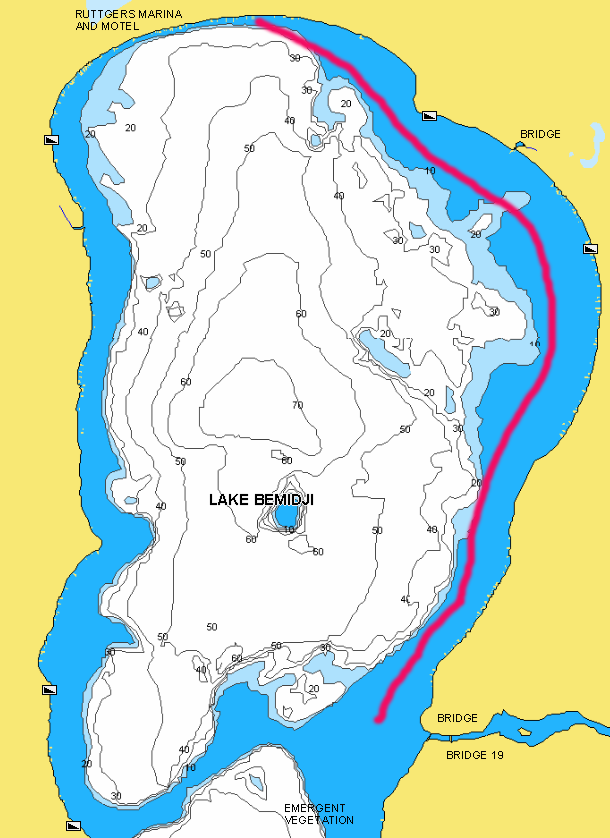
4. Trolling a bottom bouncer and spinner rig for walleyes along inside weedlines, as well as the outside edge and down to the thermocline, is a top tactic through the mid-summer months, as is a jig-and-plastic combo. Cast an RZ Jig tipped with an Impulse® Smelt Minnow or similar soft plastic lure. Fancast, and allow the jig to sink to the bottom. Give it a rip, then let it fall back to the bottom. Look for perch on the flats already mentioned.
If the fish become conditioned to the spinner rig, savvy anglers switch to a Bemidji rig, consisting of a 1/8-ounce sinker ahead of a single spinner and bait hook tipped with a white curly-tail type grub, such as an Impulse® Swim’n Grub. Troll them over the weed tops and through sparse vegetation.
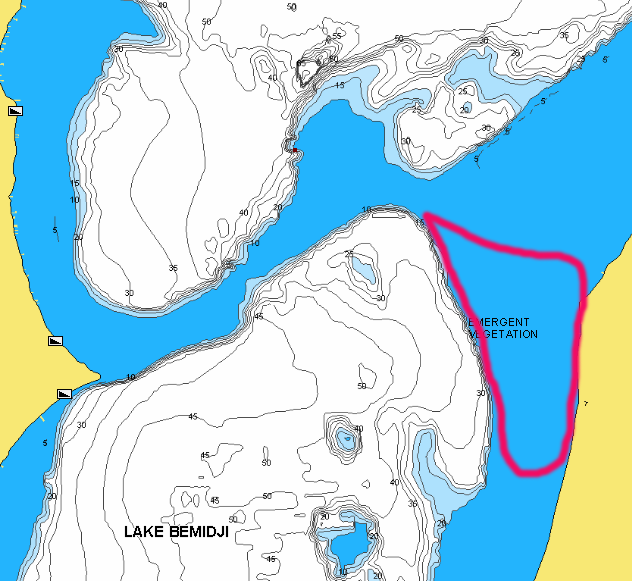
Fish weeds wherever you find them, but this is also the time to focus on the expanse of shallow flats, containing patches of weeds and rocks, from the lake’s north end down the east shoreline all the way to Diamond Bar Point. Walleyes will be scattered along the flats, and you’ll likely pick up mid-summer perch as well.
Bass anglers this time of year should concentrate on the vast reed beds south of Diamond Point Bar along the east shoreline, Nelson says. Try casting soft plastic tube baits, soft plastic stickbait, spinnerbaits, and other proven bass lures.
Vital Stats
Lake Bemidji
Size: 6,420 acres
Maximum Depth: 76 feet
Average Depth: 34 feet
Average Water Clarity: 5 feet
Shoreline: 15.4 miles
Species Present: Walleyes, Yellow Perch, Northern Pike, Muskellunge, Lake Whitefish, Bullheads, Tullibees, Minnows, Suckers, Largemouth Bass

